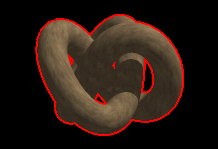|
Object Outlining by (06 May 2002) |
Return to The Archives |
Introduction
 |
|
I was recently charged with the task of rendering outlines around models in the
game I am working on to show when they are selected. There are a number of
techniques available for accomplishing this, however they typically produce
outlines of inconsistent line weight or fail to accurately represent the
silhouette of the object. In this short article I'll present my solution to the problem of producing an accurate, constant weight outline around a polygonal mesh. It recently came to my attention that a similar method was originally published by Rossignac and van Emmerik [1] in 1992.  When rendering the object, write a constant value into the stencil buffer. Then to draw the outline, render the object in wireframe using thick lines wherever the stencil buffer is unset. This will leave a outline around the border of the mesh which is one half the wireframe line thickness. This can be implemented in OpenGL as shown in the following code snippet.
One additional detail demonstrated in the sample code is that the stencil buffer can be reset to zero as the wireframe mesh is being rendered. This is done so that each pixel in the outline is rendered only once. When drawing the outline using alpha blending this can be essential to ensure a uniform opacity along the entire outline. |
Additional Notes
 |
|
If rendering the wireframe version of the mesh is a performance bottleneck,
then a simple geometric silhouette detection method can be used to reduce the
number of lines which need to be drawn. This algorithm works by identifying
edges in the mesh which are bordered by a 'front facing' face and a 'back facing'
face. In addition to including all of the lines which make up the true
silhouette of the mesh, this set of edges may also include lines which will
fall in the interior of the mesh when they are rendered, however these lines
will be discarded by the stencil operation described in the first section. Direct3D does not support thick line rendering, however the same result can be achieved by drawing the lines using a camera-facing quad. Pierre Terdiman presents source code [2] to accomplish this. Finally, it may be prohibitive for an application to require a stencil buffer just to achieve the outline effect. In the abscense of a stencil buffer, the depth buffer can be used in a similar manner as descibed by Rossignac and van Emmerik [1]. |
References
 |
|
[1] J. Rossignac and M. van Emmerik. Hidden contours on a framebuffer. In
Proceedings of the 7th Workshop on Computer Graphics Hardware, Eurographics,
September 1992. [2] Pierre Terdiman. Textured Lines In D3D |
|
|